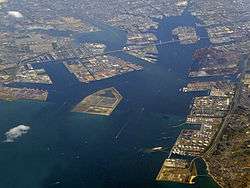Port of Nagoya
| Port of Nagoya 名古屋港 | |
|---|---|
|
Port of Nagoya | |
| Location | |
| Country | Japan |
| Location | Ise Bay |
| Coordinates | 35°05′N 136°53′E / 35.08°N 136.88°E |
| Details | |
| Opened | November 10, 1907 |
| Operated by | Nagoya Port Authority |
| Size of harbor | 82,279,000 square metres (885,640,000 sq ft) [1] |
| Land area | 42,133,000 square metres (453,520,000 sq ft) [1] |
| Available berths | 290[2] |
| Piers | 21 |
| Statistics | |
| Annual cargo tonnage | 165,000,000[3] |
| Annual container volume | 2,110,000[3] |
| Value of cargo | ¥16.7 trillion JPY (2009)[1] |
|
Website www | |

The Port of Nagoya (名古屋港 'Nagoyakō'), located in Ise Bay, is the largest and busiest trading port in Japan, accounting for about 10% of the total trade value of Japan. Notably, this port is the largest exporter of cars in Japan and where the Toyota Motor Corporation exports most of its cars.[1] It has piers in Nagoya, Tōkai, Aichi, Chita, Aichi, Yatomi, Aichi, and Tobishima, Aichi.
Its mascots are Potan and Mitan.
According to Japanese media sources, Kodo-kai, a Yakuza faction in the Yamaguchi-gumi group, earns large revenues by controlling the stevedoring and warehousing companies at the port.[4]
Notable sites
The port draws tourists from the Chūkyō Metropolitan Area as one of its primary tourist attractions. The main attraction is the port's famous Port of Nagoya Public Aquarium. Nearby is also an amusement park and the now-retired Antarctic survey ship Fuji which moors at the Port of Nagoya as a museum of the South Pole and its journeys there.
The Isewangan Expressway includes three impressive bridges, collectively known as the Meikō Triton, which span the port.
In the waters of the port on a small artificial island, there is a wildflower garden called Bluebonnet.[5]
Sister ports
 Port of Los Angeles, United States (since 1959)
Port of Los Angeles, United States (since 1959) Port of Fremantle, Australia, Australia (since 1983)
Port of Fremantle, Australia, Australia (since 1983) Port of Baltimore, United States (since 1985)
Port of Baltimore, United States (since 1985).svg.png) Port of Antwerp, Belgium (since 1988)
Port of Antwerp, Belgium (since 1988) Port of Shanghai, China (since 2003)
Port of Shanghai, China (since 2003) Port of Sydney, Australia (since 2010)
Port of Sydney, Australia (since 2010)
See also
- Nagoyakō Station
- Isewan Terminal Service
- List of East Asian ports
- Nagoya Port Drawbridge
- Aonami Line
References
- 1 2 3 4 "Port Profile". Nagoya Port Authority. Retrieved 29 December 2010.
- ↑ "Facilities". Nagoya Port Authority. Retrieved 29 December 2010.
- 1 2 "Statistics 2009". Nagoya Port Authority.
- ↑ Sentaku Magazine (reprinted in the Japan Times), "Kodo-kai still raking in funds despite tougher yakuza laws", 23 October 2015
- ↑ "Nagoya Port Wildflower Garden Bluebonnet". JTB.
External links
| Wikimedia Commons has media related to Port of Nagoya. |
